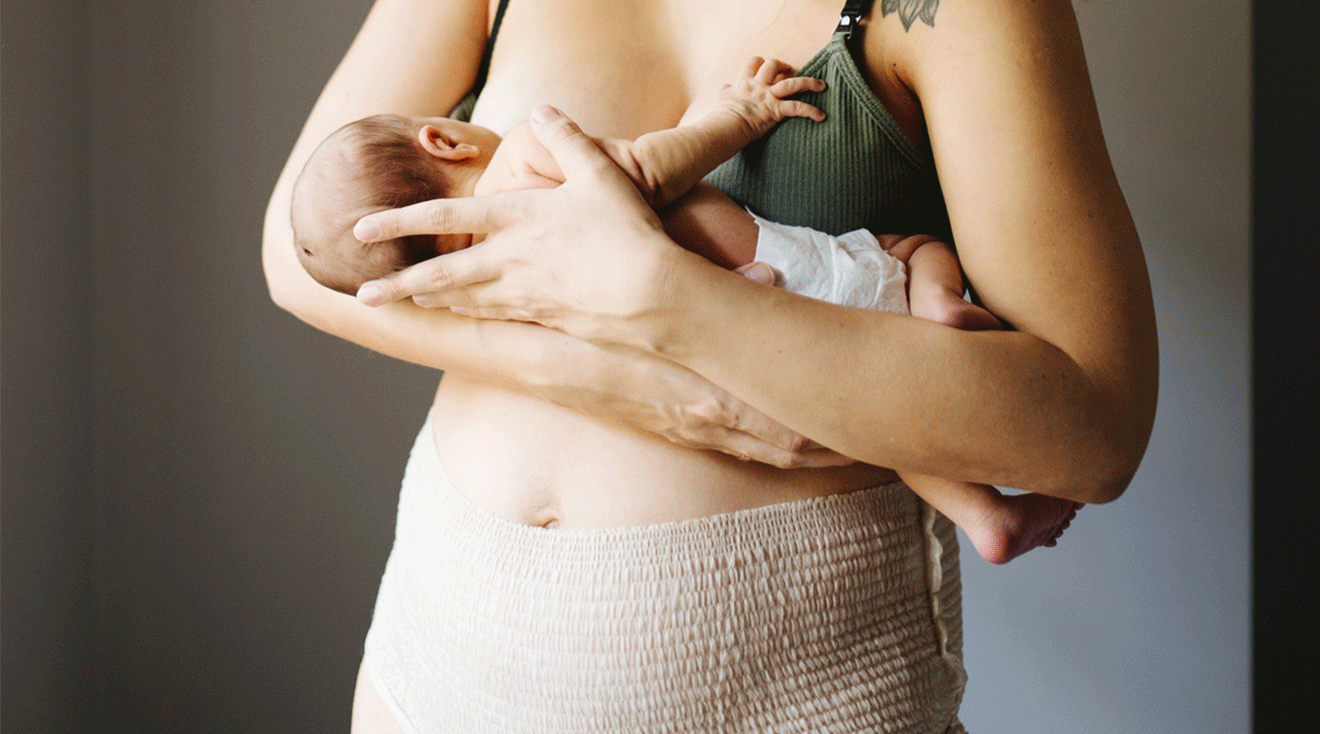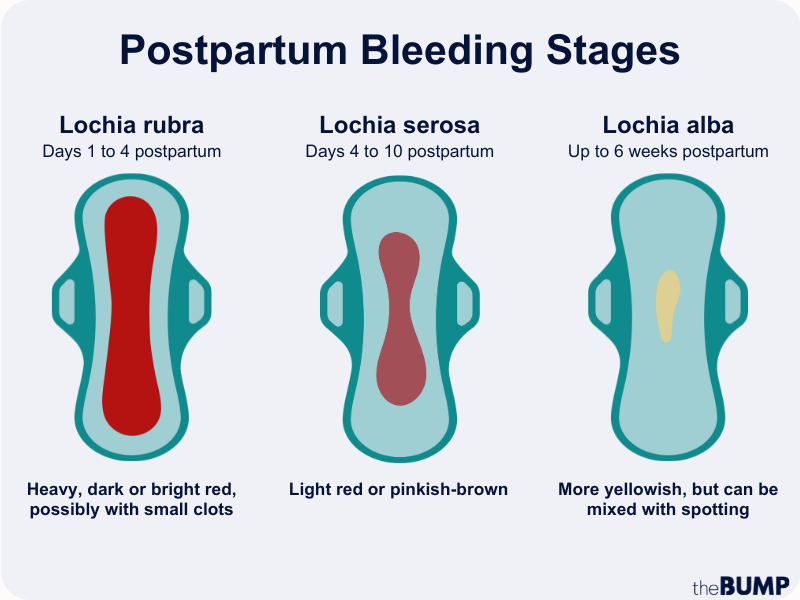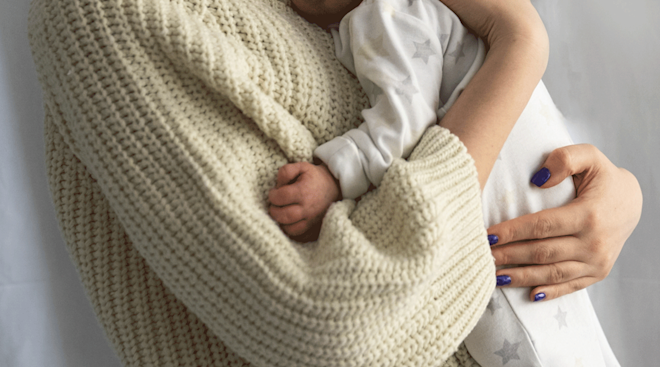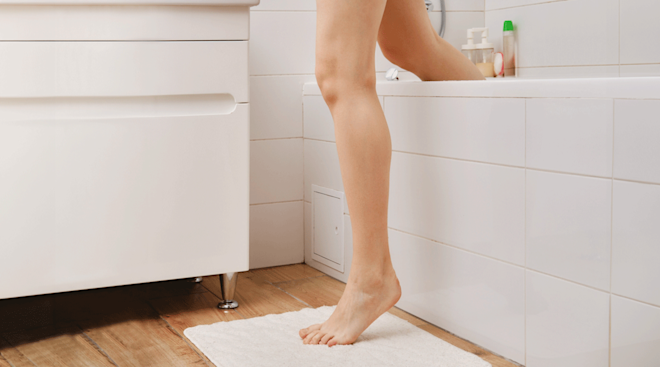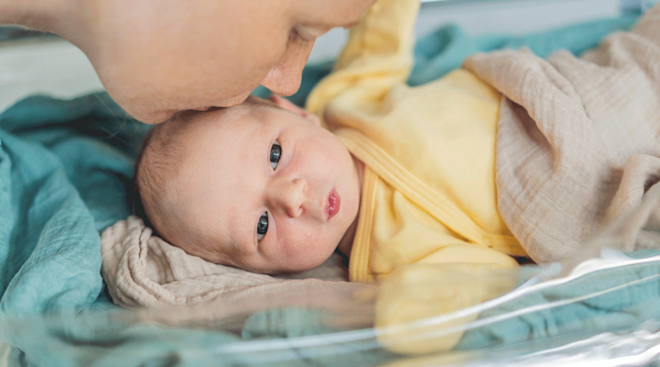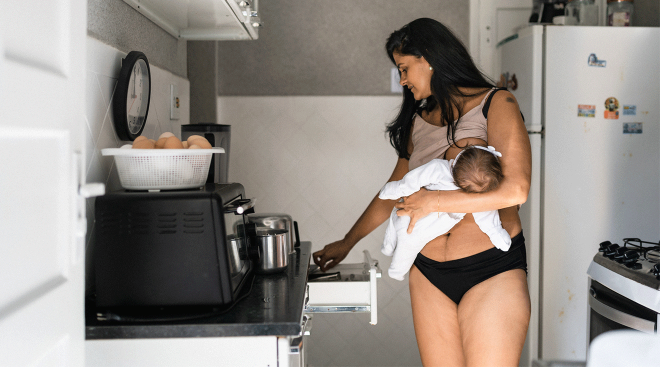What to Know About Lochia—or Postpartum Bleeding
If there’s a perk of pregnancy (you know, besides the arrival of baby), it’s the absence of a monthly period for nine+ months. But as soon as baby is born, you’ll experience what’s called postpartum lochia. Basically, it’s the normal bleeding that can stretch on for a few weeks after delivery.
Postpartum bleeding is the last thing you want to deal with while juggling sleepless nights, establishing a feeding schedule and handling endless diaper changes. But lochia is actually beneficial; it’s your body’s way of clearing out any placental material that’s left after baby is born. Ready to get the lowdown on lochia? From lochia stages to color and odor, here’s everything you need to know about this completely normal part of the postpartum process.
- You should expect postpartum bleeding to last up to six+, whether you had a vaginal birth or C-section.
- There are three lochia stages: lochia rubra, lochia serosa and lochia alba. The first stage is the heaviest; your postpartum bleeding will typically get progressively lighter and fade into discharge.
- If your postpartum bleeding lasts longer than eight weeks, suddenly gets heavier or you have a fever, check in with your doctor.
I always tell my patients that lochia is nature's way of getting you back after not having had a period during the 40 weeks while you were pregnant.
Lochia is the medical term for postpartum bleeding, says Heather Lopez, MD, an ob-gyn with BJC Medical Group at Missouri Baptist Medical Center. While this is a good basic explanation, your body is actually shedding more than just blood. “Lochia is fluid made up of blood, remaining placental cells, sloughing of the endometrial lining as well as mucus,” Lopez says. “Lochia mainly comes from the site at which the placenta detached from the uterine wall during birth.”
You can expect lochia to be a bit heavier than your normal period; it’ll probably last longer too. The good news is that any lochia you’re experiencing will gradually become lighter, both in flow and color. This is a normal progression that indicates you’re moving through the different lochia stages.
Lochia is par for the postpartum course—and while it’s not an ideal addition to the fourth-trimester experience, any heavy-duty bleeding usually subsides after a few days. Here are the three lochia stages to know about:
Lochia rubra
Immediately following baby’s birth, you can expect to experience heavy, dark red or bright red bleeding that may contain small clots. This is the first lochia stage, called lochia rubra (rubra meaning red). Those pads provided by the hospital may seem huge and hefty, but you’ll be grateful for them during this early stage of lochia. It’s also normal to experience significant uterine cramping during these first few days. Lochia rubra typically lasts for the first three to four days after birth, says Lopez, and then you’ll enter the second stage: lochia serosa.
Lochia serosa
During the second stage of lochia, you’ll still be bleeding, but it’ll probably feel much more manageable. Suffice to say, the lochia serosa stage is significantly less aggressive. “Bleeding usually becomes lighter during this time, and you’ll notice the color of your bleeding can change from a light red to a watery pink-brownish color,” says Lopez. For most new moms, lochia serosa sticks around a bit longer than lochia rubra; you can expect this stage from about day four to day 10 postpartum.
Lochia alba
Finally, the lighter bleeding of the lochia serosa stage will fade into discharge; the lochia color will now be more yellowish but can sometimes be mixed with a bit of spotting. This is the final lochia stage, called lochia alba, and it may last for up to eight weeks after delivery.
Mine started again two weeks postpartum right as I started driving again. It freaked me out, but the doctor said it was normal, especially if you’re pumping. I find it's heavier when I overexert myself. Called the doctor’s office today and they still say it's normal, and normal to have cramping as well because your uterus is shrinking back down to size.
Of course, you’re probably eager to move on and enjoy the early days with baby without the inconvenience of postpartum lochia—so exactly how long does bleeding last after birth? Like just about everything related to the pregnancy, delivery and postpartum experience, lochia after birth will vary from person to person. And you can experience it regardless of how you deliver: there’s lochia after vaginal birth and lochia after C-section too. Bleeding after both a vaginal delivery and a cesarean can last sometimes up to six to eight weeks. Rest assured that, for the most part, lochia should taper off significantly by that point.
Lochia after vaginal birth
Lochia after a vaginal birth will likely be heavier than bleeding after a C-section. If you tore during childbirth or had an episiotomy, you could be bleeding from that site as well, adding insult to injury.
Lochia after C-section
If you have a C-section, you might be surprised to learn that you’ll still experience lochia and postpartum discharge. The upside is that the bleeding might be a bit less heavy for you than it is for those moms who’ve had vaginal births. Still, the placenta has been separated from the uterus, exposing open blood vessels—so, yes, some bleeding will happen.
By the sixth week, the bleeding will likely subside—but it’s not abnormal for lochia to stop, turn red and then fade back again, especially during the early stages. Often, this is simply a side-effect of trying to do too much, too soon after delivery. Breastfeeding moms may also notice an increase in lochia during nursing sessions, according to Cleveland Clinic; a spike in the hormone oxytocin causes contractions which can lead to more uterine shedding.
There is a rare postpartum bleeding complication to be aware of called subinvolution. This is characterized by intense vaginal bleeding about two to three weeks after delivery, when you think your lochia has just about ended. “In this case, the scab located in the spot where the placenta was attached to the uterine wall falls off prematurely, and you now have an open kind of bleeding,” explains Heather Bartos, MD, medical director at Be. Women’s Health and Wellness in Frisco, Texas.
If you suddenly start bleeding very heavily again, call your doctor or midwife right away. “You might be admitted to the hospital for Pitocin or other medicine to help clamp down the uterus,” says Bartos. “It helps squeeze the site where the scab fell off to help compress the bleeding.”
I only very lightly bled for about five days postpartum—and then used a pantyliner for another half week for spotting. And that was it.
By now, you know that lochia can be slightly different for every new mom. Of course, you may still be wondering what situations might be cause for concern when it comes to postpartum bleeding. Signs of abnormal lochia discharge can include:
- Foul-smelling lochia. There is a normal lochia smell; it takes on a bit of a musty odor, similar to that of menstrual blood. But if lochia smells foul, it can indicate an infection. It can be difficult to distinguish one odor from another, but if you notice a sudden change in the way your discharge smells, it warrants a call to your doctor, says Bartos.
- Lochia with fever and/or tenderness. Any fever that occurs following baby’s birth should be discussed with your doctor, as it can indicate the start of an infection, says Bartos.
- Lochia that suddenly becomes very heavy. As previously mentioned, a sudden change in the flow of your bleeding after birth typically just means you’ve been too active too soon. Try to rest (easier said than done, we know). Either way, it’s wise to keep an eye on the sudden onset of heavy bleeding, since it can also be a sign of subinvolution or a dangerous hemorrhage; if you’re soaking a pad every hour or two, or pass large clots, you should seek help right away.
Bleeding after birth may not be pleasant, but it’s completely normal. And before you know it, those first few physically tumultuous postpartum weeks will pass, and you’ll begin to feel more like yourself again. In the meantime, being prepared to keep yourself as comfortable as possible can help you deal with lochia. “Make sure you have plenty of pads at your disposal; try the overnight size pads, and be sure to have some throwaway underwear like granny panties at home ready to go,” Bartos says. You should be able to downgrade to light or mini pads within a few days. Just don’t use tampons for lochia; nothing should go in your vagina for at least six weeks after birth. (And, for the record, you’ll want to get the go ahead from your provider at your postpartum checkup.)
At three weeks, I picked up my son's car seat and took him out for a couple hours and started bleeding heavily again. I went to the doctor and she said it was my body telling me I was overworking myself… It’s crazy how my body knew when I was doing stuff I shouldn't have been doing.
Call your healthcare provider if: Your postpartum bleeding lasts longer than six to eight weeks and/or suddenly gets heavier You notice a sudden change in the way your lochia smells You experience lochia with fever or tenderness
Frequently Asked Questions
How long do you bleed after vaginal birth?
Postpartum bleeding can last up to eight weeks. After a vaginal birth, the bleeding is typically heavier than after a C-section. If you’re bleeding for longer than six weeks, make sure to check in with your healthcare provider.
How long do you bleed after C-section?
While recovering from a C-section, you should also expect to bleed for up to six weeks. If it lasts longer, make sure to see your doctor.
Should lochia have a smell?
“Many times, it has a musty smell because it’s older blood, but if there’s a very strong odor, then you could have something else going on and should make sure you inform your doctor,” says Christine Greves, MD, FACOG, an ob-gyn at the Orlando Health Women’s Institute.
My bleeding after birth stopped, then started again. Should I see my doctor?
“If it’s within the first six weeks, and it’s not heavy and you’re feeling okay, you can observe,” says Greves. But if it’s heavy—or you’re having fever, chills or pain, or otherwise not feeling well—you should tell your doctor.
How long does bleeding last after birth if breastfeeding?
Typically, postpartum bleeding will last up to six weeks whether you’re breastfeeding or not, says Greves. “After that, your period presentation varies,” she says. “Sometimes women who are breastfeeding don’t ovulate, and therefore won’t have a period. Other women do.”
Is postpartum bleeding after six weeks normal?
It can be normal and isn’t necessarily a reason to freak out, says Greves. But it’s still best to mention it to your doctor in case you need further evaluation, she adds.
Is bleeding after intercourse normal during the postpartum stage?
Ob-gyns typically advise against sex after birth during the first six weeks to allow for healing, notes Greves. If you have post-sex bleeding after six weeks, make sure to bring it up to your doctor.
The best thing you can do during this postpartum period is try to take it easy. Yes, you now have a tiny, helpless human being to care for (and that can inhibit your ability to put your feet up), but you need to prioritize your recovery too. Labor and delivery is hard on your body. Accept help (better yet, proactively ask for it!) so that you can rest and relax as needed. Postpartum lochia is inevitable, but allowing yourself to slow down can help give you some relief.
Please note: The Bump and the materials and information it contains are not intended to, and do not constitute, medical or other health advice or diagnosis and should not be used as such. You should always consult with a qualified physician or health professional about your specific circumstances.
Plus, more from The Bump:
Heather Bartos, MD, is the medical director of Be. Women’s Health and Wellness in Frisco, Texas. A navy veteran, she spent 12 years serving the women and spouses of the armed forces, and was an associate professor at the Uniformed Services University of Health Sciences in Bethesda, Maryland. She completed her residency at Baylor College of Medicine, and earned her medical degree at The University of Texas.
Christine Greves, MD, FACOG, is an ob-gyn at the Orlando Health Women’s Institute. She received her medical degree from the University of South Florida College of Medicine.
Heather Lopez, MD, is an ob-gyn with BJC Medical Group at Missouri Baptist Medical Center. She earned her medical degree from Florida State University College of Medicine in Tallahassee.
Cleveland Clinic, Pregnancy: Physical Changes After Delivery, January 2018
Learn how we ensure the accuracy of our content through our editorial and medical review process.
Navigate forward to interact with the calendar and select a date. Press the question mark key to get the keyboard shortcuts for changing dates.
































